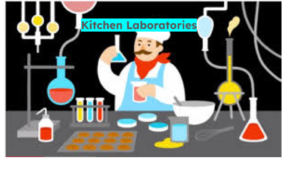Science is not all about beakers, flasks, bubbly chemicals, or fancy laboratories. Particularly, your kitchen holds its own wonders of science. All the major branches of science are at play, including biology, chemistry, and physics! In this article, we will explore the different ways that the kitchen could be your most valuable laboratory.
Let’s start with one of the most simple processes: the formation of ice. We all know that to make ice you first need to pour water into a cup and place it in the freezer. After a few hours, it turns into ice. The scientific term associated with water and ice in this example is called the physical state. Water’s physical state is liquid and ice is solid. The change of a physical state is called a transformation. Here, the transformation is the water’s liquid state turning into ice, the solid state. This seems simple so far, so let’s take a closer look at what’s really happening. As the temperature drops, water molecules lose energy and begin to arrange themselves into a crystalline structure, or a lattice structure. Think of it like LEGO blocks. Stacked LEGO blocks form larger structures and attach to each other through grooves, or bonds. Similarly, ice forms through bonds, forming a lattice structure. Additionally, the formation of ice is an exothermic process, meaning it releases heat. But wait, isn’t heat associated with melting? Yes, but exothermic in this scenario means that as the temperature drops, water releases heat to the surroundings, allowing itself to cool to its freezing point, lose energy, and begin to form an ice structure. On the contrary, the endothermic process would be the melting of ice. When the solid physical state of ice is transformed to its liquid phase of water. Here, the ice absorbs heat energy from the environment, breaks bonds, and becomes liquid again. This is nothing but physics and chemistry!
Fruits and vegetables are essential to maintain a healthy, nutritious diet, and making a salad is a great way to maintain this balance. But you probably didn’t realize that your salad dressing could be a result of emulsification. Let me explain; oil and vinegar when mixed together don’t normally go well together. Their differences in polarity make them generally immiscible, or insoluble. But, you could actually prevent them from coalescing or separating by adding an emulsifier, which help disperse tiny droplets from one liquid throughout the other liquid. Upon equal dispersion, the emulsifier helps stabilize this mixture and maintains its “mixed” state. Common emulsifiers in the kitchen include egg yolk and mustard. But it’s not just used in salad dressings, emulsification is a core part of the culinary world, and its principles are used in many recipes where achieving a smooth and uniform texture is desired. Another chemistry concept!
Did you know some yogurt samples have over 100 million bacteria per gram? No, it’s not the ‘germs,’ but it’s the healthy bacteria that helps maintain your gut microbiome (which contains TRILLIONS of microbes). These bacteria are also vital to the formation of yogurt. Let’s take kefir, for example, a probiotic rich type of yogurt. To make kefir, all you need is a potent starting culture and some milk. Upon adding a few teaspoons of culture to the milk, your yogurt will be ready in a few hours! How does this work? The starting culture is a rich mixture of microorganisms and bacteria which convert the lactose present in the milk into lactic acid. The conversion of lactose into lactic acid over the course of several hours causes the build up of lactic acid, creating the pH of the milk to drop due to the acidic environment. Ever had super tangy yogurt? That’s because of lactic acid! As the lactic acid accumulates, it coagulates to form this gel-like structure, which is what gives yogurt the thick and creamy texture. If you’re not a fan of tangy yogurt, store the yogurt in the fridge at cold temperatures, which will halt the fermentation process and decrease the excess build up of lactic acid! So, the next time you indulge in a yogurt parfait, think about the biological and chemical aspects at play!
Similarly, nearly every process of measuring, mixing, cooking, baking, and serving involves all branches of science, mathematics, and even structural engineering when a wedding cake is stacked tall on a cake stand!
For the ultimate recipe, all you need is a curious mind, interest to learn, and observation skills. With these ingredients, your kitchen will turn into the biggest scientific treat available, always ready for endless experimentation and scientific inquiry. (And, you don’t need to go to the grocery store!)
image credits: foodbeast.com






